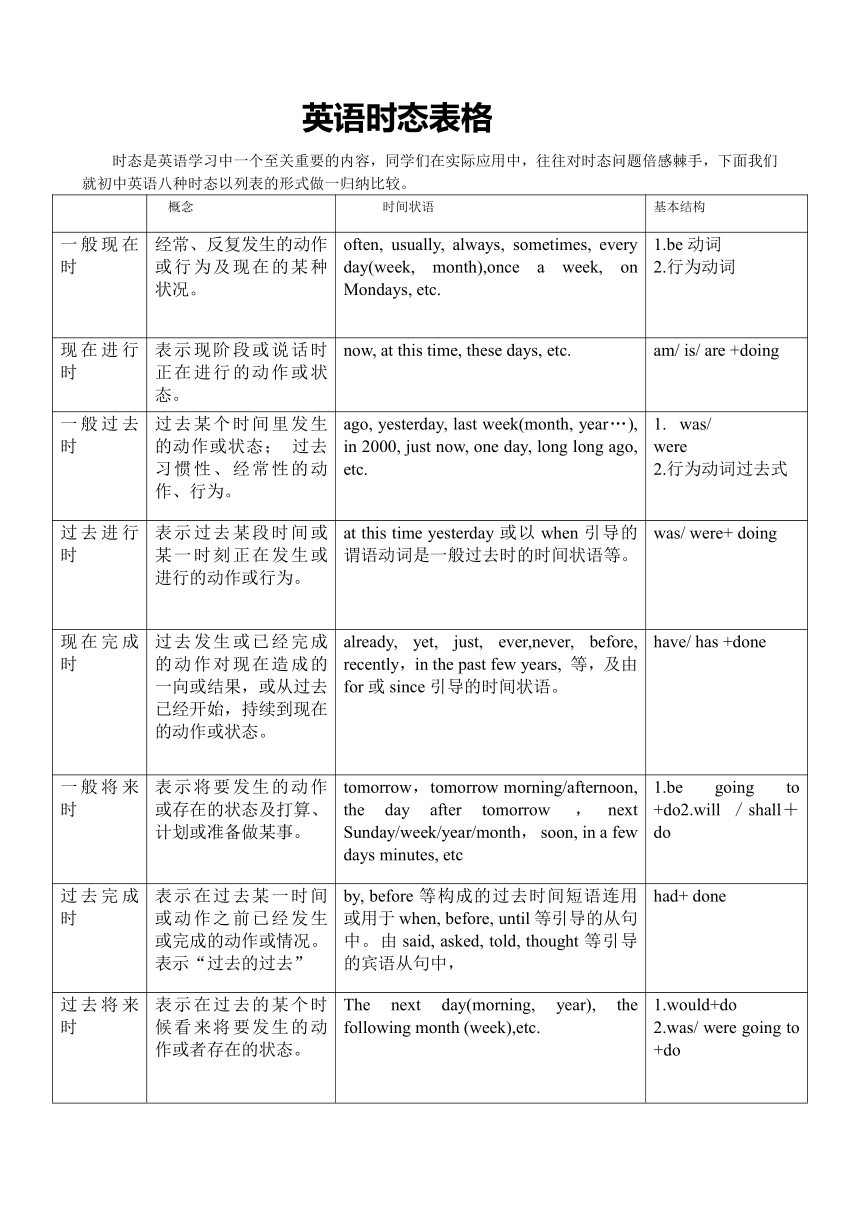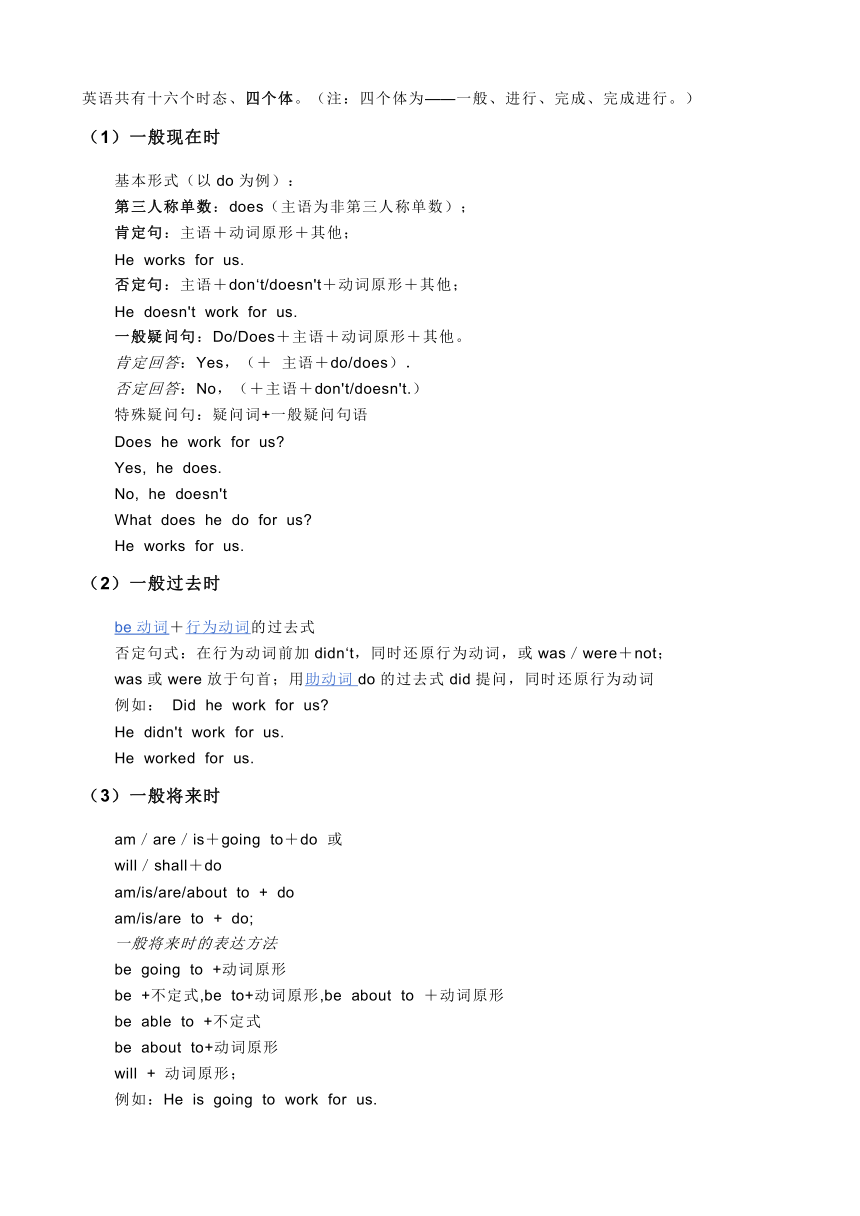2023届中考英语二轮复习:英语时态表格总结
文档属性
| 名称 | 2023届中考英语二轮复习:英语时态表格总结 |  | |
| 格式 | zip | ||
| 文件大小 | 49.0KB | ||
| 资源类型 | 教案 | ||
| 版本资源 | 通用版 | ||
| 科目 | 英语 | ||
| 更新时间 | 2022-12-10 17:46:57 | ||
图片预览


文档简介
英语时态表格
时态是英语学习中一个至关重要的内容,同学们在实际应用中,往往对时态问题倍感棘手,下面我们就初中英语八种时态以列表的形式做一归纳比较。
概念 时间状语 基本结构
一般现在时 经常、反复发生的动作或行为及现在的某种状况。 often, usually, always, sometimes, every day(week, month),once a week, on Mondays, etc. 1.be动词2.行为动词
现在进行时 表示现阶段或说话时正在进行的动作或状态。 now, at this time, these days, etc. am/ is/ are +doing
一般过去时 过去某个时间里发生的动作或状态; 过去 习惯性、经常性的动作、行为。 ago, yesterday, last week(month, year…), in 2000, just now, one day, long long ago, etc. was/were2.行为动词过去式
过去进行时 表示过去某段时间或某一时刻正在发生或进行的动作或行为。 at this time yesterday或以when引导的谓语动词是一般过去时的时间状语等。 was/ were+ doing
现在完成时 过去发生或已经完成的动作对现在造成的一向或结果,或从过去已经开始,持续到现在的动作或状态。 already, yet, just, ever,never, before, recently,in the past few years, 等,及由for或since引导的时间状语。 have/ has +done
一般将来时 表示将要发生的动作或存在的状态及打算、计划或准备做某事。 tomorrow,tomorrow morning/afternoon, the day after tomorrow ,next Sunday/week/year/month, soon, in a few days minutes, etc 1.be going to +do2.will /shall+do
过去完成时 表示在过去某一时间或动作之前已经发生或完成的动作或情况。表示“过去的过去” by, before等构成的过去时间短语连用或用于when, before, until等引导的从句中。由said, asked, told, thought等引导的宾语从句中, had+ done
过去将来时 表示在过去的某个时候看来将要发生的动作或者存在的状态。 The next day(morning, year), the following month (week),etc. 1.would+do 2.was/ were going to +do
英语共有十六个时态、四个体。(注:四个体为——一般、进行、完成、完成进行。)
(1)一般现在时
基本形式(以do为例):
第三人称单数:does(主语为非第三人称单数);
肯定句:主语+动词原形+其他;
He works for us.
否定句:主语+don‘t/doesn't+动词原形+其他;
He doesn't work for us.
一般疑问句:Do/Does+主语+动词原形+其他。
肯定回答:Yes,(+ 主语+do/does).
否定回答:No,(+主语+don't/doesn't.)
特殊疑问句:疑问词+一般疑问句语
Does he work for us
Yes, he does.
No, he doesn't
What does he do for us
He works for us.
(2)一般过去时
be动词 ( http: / / baike. / view / 585473.htm" \t "_blank )+行为动词 ( http: / / baike. / view / 875187.htm" \t "_blank )的过去式
否定句式:在行为动词前加didn‘t,同时还原行为动词,或was/were+not;
was或were放于句首;用助动词 ( http: / / baike. / view / 78719.htm" \t "_blank )do的过去式did提问,同时还原行为动词
例如: Did he work for us
He didn't work for us.
He worked for us.
(3)一般将来时
am/are/is+going to+do 或
will/shall+do
am/is/are/about to + do
am/is/are to + do;
一般将来时的表达方法
be going to +动词原形
be +不定式,be to+动词原形,be about to +动词原形
be able to +不定式
be about to+动词原形
will + 动词原形;
例如:He is going to work for us.
He will work for us;
He is coming.这是特殊的用一般现在时 表达 将来时态 的例子!!
(4)过去将来时
be(was,were)going to+动词原形
be(was,were)about to+动词原形
be(was,were)to+动词原形
肯定句:主语+be(was,were)going to+动词原形~.
否定句:主语+be(was,were)not going to+动词原形~.
疑问句:Be(Was,Were)+主语+going to+动词原形~?
肯定句:主语+would(should)+动词原形~.
否定句:主语+would(should)not+动词原形~.
疑问句:Would(Should)+主语+动词原形~?
He would work for us.
(5)现在进行时
主语+be+v.ing〔现在分词〕形式(其中v表示动词)
表示现在正在进行的动作或最近在做的事。
例如:I am buying a book.
第一人称+am+doing+sth
第二人称+are+doing +sth (doing是泛指所有的v-ing形式)
第三人称+is+doing+sth
例:He is working.
(6)过去进行时
肯定句:主语+was/were+doing+其它
否定句:主语+was/were+not+doing+其它
一般疑问句及答语:Was/Were+主语+doing+其它 ;答语:Yes,I主语+was/were./No,I主语+wasn't/weren't.
特殊疑问句:特殊疑问词+was/were+主语+doing+其它
He was working when he was alive.
(7)将来进行时
主语+will + be +现在分词
He will be working for us.=He will work for us.
(8)过去将来进行时
should(would)+be+现在分词
He said that he would be working for us.=He said that he would work for us.
(9)现在完成时
基本结构:主语+have/has+过去分词(done)
①肯定句:主语+have/has+过去分词+其他
②否定句:主语+have/has+not+过去分词+其他
③一般疑问句:Have/Has+主语+过去分词+其他
④特殊疑问句:特殊疑问词+一般疑问句(have/has+主语+过去分词+其他\
He has worked for us for ten years.
Has he worked for us for ten years.
(10)过去完成时
基本结构:主语+had+过去分词(done)
①肯定句:主语+had+过去分词+其他
②否定句:主语+had+not+过去分词+其他
③一般疑问句:Had+主语+过去分词+其他
肯定回答:Yes,主语+had
否定回答:No,主语+hadn't
④特殊疑问句:特殊疑问词+一般疑问句(had+主语+过去分词+其他)
语法判定:
( 1 ) by + 过去的时间点。如:
I had finished reading the novel by nine o'clock last night.
( 2 ) by the end of + 过去的时间点。如:
We had learnt over two thousand English words by the end of last term.
( 3 ) before + 过去的时间点。如:
They had planted six hundred trees before last Wednesday.
(11)将来完成时
(shall)will+have+动词过去分词
before+将来时间或by+将来时间
before或by the time引导的现在时的从句 ( http: / / baike. / view / 138129.htm" \t "_blank )
He will have worked for us.=He will work for us.
(12)过去将来完成时
should / would have done sth.
He said that he would have worked for us.=He said that he would work for us.
(13)现在完成进行时
基本与现在完成时相同,但是现在完成进行时只能表示仍然持续的概念
have/has been +-ing 分词
He has been working for us for ten years.=He has worked for us for ten years.
(14)过去完成进行时
had been +-ing 分词
He said that he had been working for us for ten years.=He said that he had worked for us for ten years.
(15)将来完成进行时
主语+ shall/will have been doing
He will have been working for us.=He will work for us.
翻译为:他最近一直在为我们工作(过去在工作,现在在工作,将来还会工作)
(16)过去将来完成进行时
should+have been+现在分词用于第一人称
would have been+现在分词用于其他人称
He said that he would have been working for us.=He said that he would work for us.
举例:
英语中有12个主要时态,都来自于三时(过去、现在、将来)
现在以I listen为例,举例英语中有12个主要时态如下所示:
一般现在时:I listen
现在进行时 ( http: / / baike. / view / 201163.htm" \t "_blank ):I am listening
过去进行时:I was listening
现在完成时:I have listened
现在完成进行时:I have been listening
一般将来时:I shall listen”或“I will listen.”
将来进行时:I shall be listening
一般过去时:I listened
过去完成时 ( http: / / baike. / view / 201153.htm" \t "_blank ):I had listened
过去完成进行时:I had been listening
将来完成时: I shall have listened
将来完成进行时: I shall have been listening
时态是英语学习中一个至关重要的内容,同学们在实际应用中,往往对时态问题倍感棘手,下面我们就初中英语八种时态以列表的形式做一归纳比较。
概念 时间状语 基本结构
一般现在时 经常、反复发生的动作或行为及现在的某种状况。 often, usually, always, sometimes, every day(week, month),once a week, on Mondays, etc. 1.be动词2.行为动词
现在进行时 表示现阶段或说话时正在进行的动作或状态。 now, at this time, these days, etc. am/ is/ are +doing
一般过去时 过去某个时间里发生的动作或状态; 过去 习惯性、经常性的动作、行为。 ago, yesterday, last week(month, year…), in 2000, just now, one day, long long ago, etc. was/were2.行为动词过去式
过去进行时 表示过去某段时间或某一时刻正在发生或进行的动作或行为。 at this time yesterday或以when引导的谓语动词是一般过去时的时间状语等。 was/ were+ doing
现在完成时 过去发生或已经完成的动作对现在造成的一向或结果,或从过去已经开始,持续到现在的动作或状态。 already, yet, just, ever,never, before, recently,in the past few years, 等,及由for或since引导的时间状语。 have/ has +done
一般将来时 表示将要发生的动作或存在的状态及打算、计划或准备做某事。 tomorrow,tomorrow morning/afternoon, the day after tomorrow ,next Sunday/week/year/month, soon, in a few days minutes, etc 1.be going to +do2.will /shall+do
过去完成时 表示在过去某一时间或动作之前已经发生或完成的动作或情况。表示“过去的过去” by, before等构成的过去时间短语连用或用于when, before, until等引导的从句中。由said, asked, told, thought等引导的宾语从句中, had+ done
过去将来时 表示在过去的某个时候看来将要发生的动作或者存在的状态。 The next day(morning, year), the following month (week),etc. 1.would+do 2.was/ were going to +do
英语共有十六个时态、四个体。(注:四个体为——一般、进行、完成、完成进行。)
(1)一般现在时
基本形式(以do为例):
第三人称单数:does(主语为非第三人称单数);
肯定句:主语+动词原形+其他;
He works for us.
否定句:主语+don‘t/doesn't+动词原形+其他;
He doesn't work for us.
一般疑问句:Do/Does+主语+动词原形+其他。
肯定回答:Yes,(+ 主语+do/does).
否定回答:No,(+主语+don't/doesn't.)
特殊疑问句:疑问词+一般疑问句语
Does he work for us
Yes, he does.
No, he doesn't
What does he do for us
He works for us.
(2)一般过去时
be动词 ( http: / / baike. / view / 585473.htm" \t "_blank )+行为动词 ( http: / / baike. / view / 875187.htm" \t "_blank )的过去式
否定句式:在行为动词前加didn‘t,同时还原行为动词,或was/were+not;
was或were放于句首;用助动词 ( http: / / baike. / view / 78719.htm" \t "_blank )do的过去式did提问,同时还原行为动词
例如: Did he work for us
He didn't work for us.
He worked for us.
(3)一般将来时
am/are/is+going to+do 或
will/shall+do
am/is/are/about to + do
am/is/are to + do;
一般将来时的表达方法
be going to +动词原形
be +不定式,be to+动词原形,be about to +动词原形
be able to +不定式
be about to+动词原形
will + 动词原形;
例如:He is going to work for us.
He will work for us;
He is coming.这是特殊的用一般现在时 表达 将来时态 的例子!!
(4)过去将来时
be(was,were)going to+动词原形
be(was,were)about to+动词原形
be(was,were)to+动词原形
肯定句:主语+be(was,were)going to+动词原形~.
否定句:主语+be(was,were)not going to+动词原形~.
疑问句:Be(Was,Were)+主语+going to+动词原形~?
肯定句:主语+would(should)+动词原形~.
否定句:主语+would(should)not+动词原形~.
疑问句:Would(Should)+主语+动词原形~?
He would work for us.
(5)现在进行时
主语+be+v.ing〔现在分词〕形式(其中v表示动词)
表示现在正在进行的动作或最近在做的事。
例如:I am buying a book.
第一人称+am+doing+sth
第二人称+are+doing +sth (doing是泛指所有的v-ing形式)
第三人称+is+doing+sth
例:He is working.
(6)过去进行时
肯定句:主语+was/were+doing+其它
否定句:主语+was/were+not+doing+其它
一般疑问句及答语:Was/Were+主语+doing+其它 ;答语:Yes,I主语+was/were./No,I主语+wasn't/weren't.
特殊疑问句:特殊疑问词+was/were+主语+doing+其它
He was working when he was alive.
(7)将来进行时
主语+will + be +现在分词
He will be working for us.=He will work for us.
(8)过去将来进行时
should(would)+be+现在分词
He said that he would be working for us.=He said that he would work for us.
(9)现在完成时
基本结构:主语+have/has+过去分词(done)
①肯定句:主语+have/has+过去分词+其他
②否定句:主语+have/has+not+过去分词+其他
③一般疑问句:Have/Has+主语+过去分词+其他
④特殊疑问句:特殊疑问词+一般疑问句(have/has+主语+过去分词+其他\
He has worked for us for ten years.
Has he worked for us for ten years.
(10)过去完成时
基本结构:主语+had+过去分词(done)
①肯定句:主语+had+过去分词+其他
②否定句:主语+had+not+过去分词+其他
③一般疑问句:Had+主语+过去分词+其他
肯定回答:Yes,主语+had
否定回答:No,主语+hadn't
④特殊疑问句:特殊疑问词+一般疑问句(had+主语+过去分词+其他)
语法判定:
( 1 ) by + 过去的时间点。如:
I had finished reading the novel by nine o'clock last night.
( 2 ) by the end of + 过去的时间点。如:
We had learnt over two thousand English words by the end of last term.
( 3 ) before + 过去的时间点。如:
They had planted six hundred trees before last Wednesday.
(11)将来完成时
(shall)will+have+动词过去分词
before+将来时间或by+将来时间
before或by the time引导的现在时的从句 ( http: / / baike. / view / 138129.htm" \t "_blank )
He will have worked for us.=He will work for us.
(12)过去将来完成时
should / would have done sth.
He said that he would have worked for us.=He said that he would work for us.
(13)现在完成进行时
基本与现在完成时相同,但是现在完成进行时只能表示仍然持续的概念
have/has been +-ing 分词
He has been working for us for ten years.=He has worked for us for ten years.
(14)过去完成进行时
had been +-ing 分词
He said that he had been working for us for ten years.=He said that he had worked for us for ten years.
(15)将来完成进行时
主语+ shall/will have been doing
He will have been working for us.=He will work for us.
翻译为:他最近一直在为我们工作(过去在工作,现在在工作,将来还会工作)
(16)过去将来完成进行时
should+have been+现在分词用于第一人称
would have been+现在分词用于其他人称
He said that he would have been working for us.=He said that he would work for us.
举例:
英语中有12个主要时态,都来自于三时(过去、现在、将来)
现在以I listen为例,举例英语中有12个主要时态如下所示:
一般现在时:I listen
现在进行时 ( http: / / baike. / view / 201163.htm" \t "_blank ):I am listening
过去进行时:I was listening
现在完成时:I have listened
现在完成进行时:I have been listening
一般将来时:I shall listen”或“I will listen.”
将来进行时:I shall be listening
一般过去时:I listened
过去完成时 ( http: / / baike. / view / 201153.htm" \t "_blank ):I had listened
过去完成进行时:I had been listening
将来完成时: I shall have listened
将来完成进行时: I shall have been listening
同课章节目录
- 词法
- 名词
- 动词和动词短语
- 动词语态
- 动词时态
- 助动词和情态动词
- 非谓语动词
- 冠词
- 代词
- 数词和量词
- 形容词副词及其比较等级
- 介词和介词短语
- 连词和感叹词
- 构词法
- 相似、相近词比较
- 句法
- 陈述句
- 一般疑问句和否定疑问句
- 特殊疑问句及选择疑问句
- 反意疑问句
- 存在句(There be句型)
- 宾语从句
- 定语从句
- 状语从句
- 主谓一致问题
- 简单句
- 并列句
- 复合句
- 主谓一致
- 主、表语从句
- 名词性从句
- 直接引语和间接引语
- 虚拟语气
- 感叹句
- 强调句
- 倒装句
- 祈使句
- 句子的成分
- 句子的分类
- 题型专区
- 单项选择部分
- 易错题
- 完形填空
- 阅读理解
- 词汇练习
- 听说训练
- 句型转换
- 补全对话
- 短文改错
- 翻译
- 书面表达
- 任务型阅读
- 语法填空
- 其他资料
